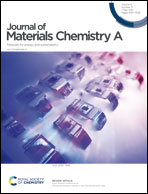Engineering metallic MoS2 monolayers with responsive hydrogen evolution electrocatalytic activities for enzymatic reaction monitoring†
Abstract
The use of a Schlenk line (SL) promotes a strategy involving N-butyllithium for the chemical exfoliation of layered crystals, with the remarkable merits of being low risk and allowing “one-pot” operation. Significantly, metallic-phase and defect-abundant nanosheets are synthesized from SL-exfoliated molybdenum disulphide (SL-MoS2), exhibiting the desired morphological features with a high percentage of monolayers and uniform planar size. Additionally, SL-MoS2 has the excellent structural features of a metallic phase and abundant defects, thereby supporting high activity during the electrocatalytic hydrogen evolution reaction (HER). Nevertheless, the unique structural and morphological characteristics of SL-MoS2 are proved to cause the rapid dissociation of the SL-MoS2 nanosheets in H2O2-rich environments, and the electrocatalytic performance accordingly declines. The HER current density, which is dependent on the number of active sites of SL-MoS2, specifically reflects the reactive-oxygen-species-based degradation of the SL-MoS2 nanoprobes; this can contribute to the electrochemical monitoring of enzyme-associated biological targets and processes using developed chips based on SL-MoS2-modified carbon fibers.



 Please wait while we load your content...
Please wait while we load your content...